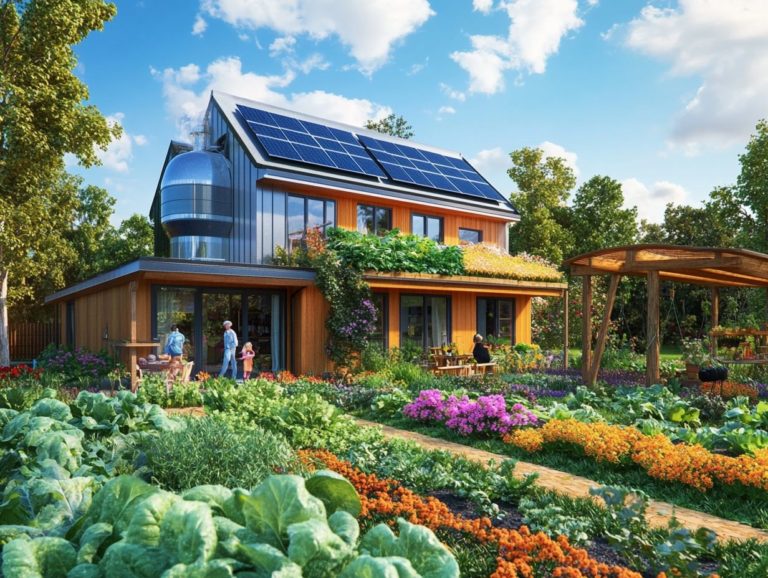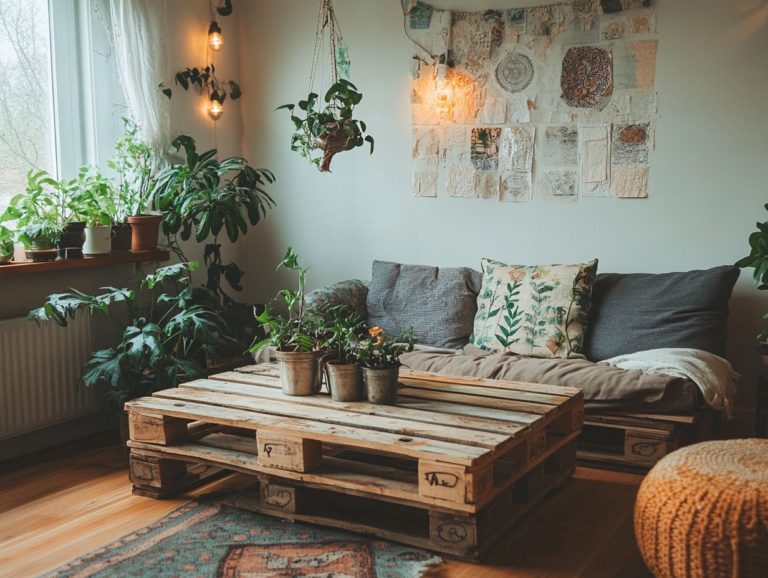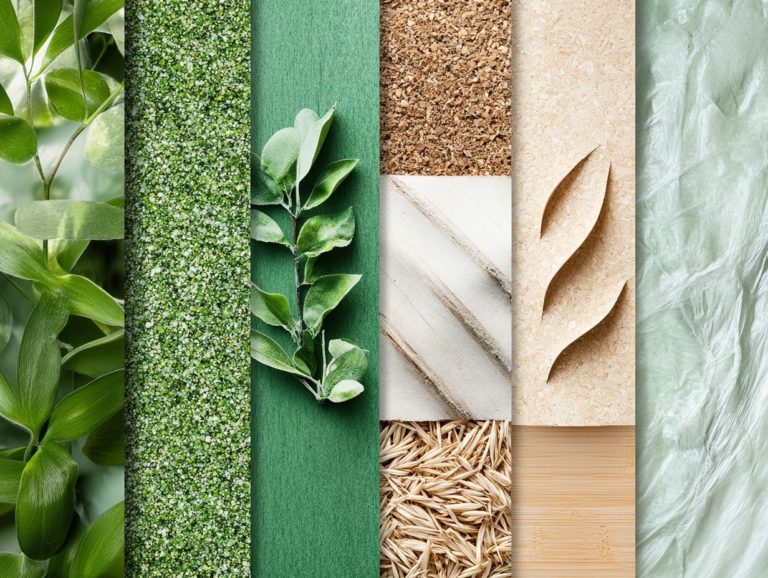Maximizing Style with Sustainable Materials in Decor
In a world that increasingly prioritizes sustainability, choosing eco-friendly materials for your home decor is not just a responsible decision it’s a stylish one, too.
This article delves into the numerous benefits of utilizing sustainable materials. You’ll discover their positive environmental impact and the health advantages they bring to your living space.
You ll uncover practical ways to incorporate these materials into your home, exploring popular options such as wood alternatives and recycled fabrics.
Excited to transform your home? Make it a stylish sanctuary of sustainability!
Contents
- Key Takeaways:
- Benefits of Using Sustainable Materials in Decor
- Incorporating Sustainable Materials into Decor
- Popular Sustainable Materials for Decor
- Eco-Friendly Fabrics
- Recycled Materials
- Tips for Maximizing Style with Sustainable Materials
- Combining Aesthetics and Sustainability
- Budget-Friendly Options
- Frequently Asked Questions
- What is sustainable decor?
- How can I incorporate sustainable materials into my decor?
- What are the benefits of using sustainable materials in decor?
- Can sustainable decor still be stylish?
- How can I make my home more sustainable without completely redecorating?
- Are sustainable materials more expensive than traditional materials?
Key Takeaways:

- Choose sustainable materials for your decor to reduce environmental impact and improve air quality in your home.
- Incorporate eco-friendly fabrics, recycled materials, and wood alternatives into your decor to achieve a stylish and sustainable look.
- Maximize style with sustainable materials by combining aesthetics and sustainability, and opting for budget-friendly options. Your home can be both chic and environmentally friendly.
Defining Sustainable Materials
Sustainable materials are sourced and processed in ways that significantly minimize environmental impact. They align beautifully with the principles of sustainable interior design.
Consider eco-friendly options like:
- Bamboo flooring
- Low VOC paints (which reduce harmful chemicals)
- Recycled materials
- Reclaimed wood
Each of these contributes to a healthier living environment while supporting sustainable practices.
By choosing these materials, you can dramatically reduce your carbon footprint and foster a cleaner atmosphere. For example, low VOC paints diminish harmful chemicals, enhancing air quality.
Reclaimed wood not only adds character and warmth to your spaces but also repurposes existing resources, minimizing waste and decreasing the demand for new materials.
Every choice you make with sustainable materials elevates eco-friendly design and champions a lifestyle that emphasizes longevity and ecological responsibility.
Benefits of Using Sustainable Materials in Decor
Utilizing sustainable materials in your decor brings a wealth of benefits:
- Waste reduction
- Improved air quality
- Enhanced energy efficiency
These elements not only contribute to a more beautiful environment but also align perfectly with the principles of sustainable interior design.
Environmental Impact
The environmental impact of traditional materials can be quite devastating, contributing to increased waste and the depletion of precious natural resources. In contrast, sustainable practices and eco-conscious brands strive to mitigate these effects through responsible sourcing and production.
By prioritizing renewable resources and adopting efficient manufacturing methods, these brands reduce their carbon footprints and establish new industry standards. For example, Patagonia and Reformation are dedicated to using organic cotton and recycled materials, significantly cutting down on pollution and waste.
Companies like Allbirds highlight sustainable footwear by incorporating natural materials such as merino wool and eucalyptus, fostering a more eco-friendly approach. This shift toward sustainability not only benefits the environment but also inspires consumers like you to make more mindful choices, ultimately cultivating a more conscientious marketplace.
Start your journey towards a sustainable home today!
Health Benefits
One of the standout health benefits of opting for sustainable materials is the remarkable improvement in indoor air quality. Choosing low VOC paints and sustainable textiles significantly enhances the safety and comfort of your living environment.
When you select these eco-friendly options, you’re actively reducing your exposure to harmful chemicals commonly found in conventional materials. For instance, low VOC paints emit fewer harmful gases into the air. This helps you avoid headaches and respiratory issues. Similarly, sustainable textiles often crafted from organic fibers and free from harmful dyes contribute to a cleaner indoor atmosphere. This is especially advantageous for sensitive groups, including children and individuals with respiratory conditions.
Ultimately, embracing sustainable materials not only creates a healthier home where you feel good every day but also promotes your overall well-being, transforming your living space into a true sanctuary of comfort and health.
Incorporating Sustainable Materials into Decor

Incorporating sustainable materials into your decor is effortlessly attainable when you make thoughtful design choices. For inspiration, explore the top decorative items for eco-conscious homes. Embracing biophilic design principles allows you to harmoniously integrate elements of nature into your space.
Opt for handmade furniture and vintage pieces that not only exude style but also champion sustainability.
Ways to Use Sustainable Materials
Get ready to discover a world of innovative options for sustainable materials in your decor. Consider choosing bamboo flooring, reclaimed wood accents, or eco-friendly paints. Not only do these choices enhance the visual appeal of your space, but they also champion sustainability.
Incorporating such materials can seamlessly blend with various decor styles, whether you lean toward modern minimalism or rustic charm. For example, imagine pairing reclaimed wood furniture with sleek, contemporary designs this creates a striking contrast that demands attention. Bamboo wall panels can infuse natural warmth into a stark, industrial space, making it feel more inviting.
Using recycled glass for lighting fixtures not only adds a unique flair to your decor but also supports eco-conscious craftsmanship. By opting for these sustainable choices, you can cultivate a living environment that is both stylish and considerate of the planet.
Popular Sustainable Materials for Decor
You’ll find that popular sustainable materials for decor, such as bamboo, eco-friendly fabrics, and recycled materials, are becoming increasingly sought after by both eco-conscious brands and discerning consumers interested in the impact of sustainable materials on home design.
Their aesthetic allure combined with a minimal environmental impact makes them a top choice for creating a stylish yet responsible living space.
Wood Alternatives
Wood alternatives such as bamboo and reclaimed wood not only enhance the aesthetic of your space but also serve as sustainable materials that help reduce deforestation. They offer both durability and style for discerning homeowners like yourself.
Options like recycled plastic lumber and composite materials are becoming increasingly popular, thanks to their remarkable resilience and minimal maintenance needs. These alternatives often replicate the natural grain of traditional wood, allowing for seamless integration into various design schemes.
Beyond their visual appeal, many of these materials boast a reduced carbon footprint, promoting a healthier environment by utilizing waste products or fast-growing renewable resources.
As you seek eco-friendly solutions, exploring these innovative materials can spark your creativity while simultaneously making a positive impact on the planet.
Eco-Friendly Fabrics
Eco-friendly fabrics, such as sustainable textiles crafted from organic cotton and other natural materials, are vital for creating a healthier home environment. They also add an elegant touch to your decor.
These materials help reduce the carbon footprint associated with traditional textile production. They promote improved air quality and safety for your family.
By choosing textiles like linen, hemp, or bamboo, you can cultivate a serene atmosphere that enhances aesthetic appeal while remaining committed to environmental responsibility.
These fabrics are especially beneficial in spaces like living rooms, nurseries, and outdoor areas. Comfort, durability, and style are essential in these settings.
The versatility of eco-friendly options opens up creative possibilities for upholstery, curtains, and other decorative elements. This demonstrates that why sustainable materials matter in home design can effortlessly combine functionality with visual charm.
Recycled Materials
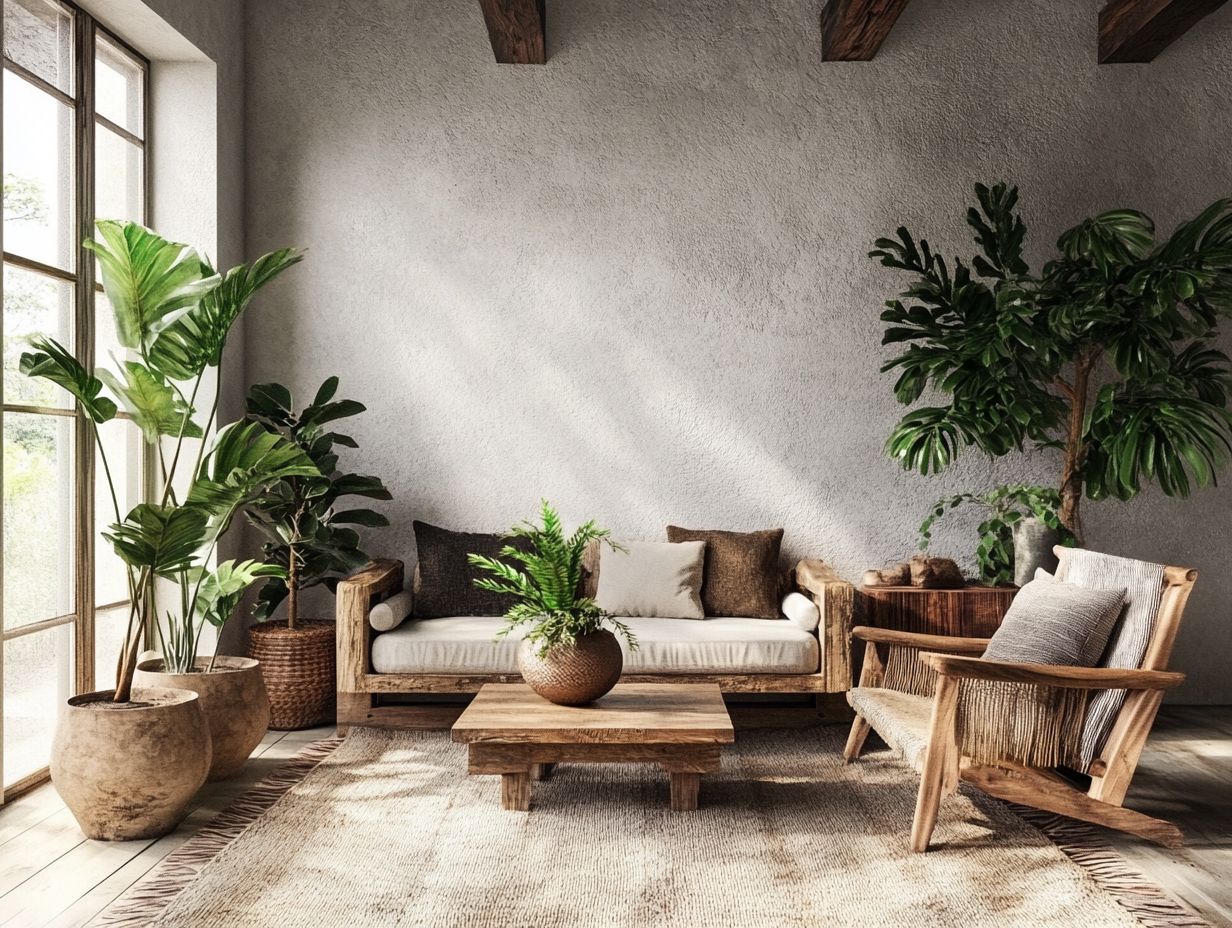
Recycled materials are essential in sustainable interior design. They provide innovative solutions that champion waste reduction and energy efficiency while adding unique flair to your decor.
You can explore various options, from reclaimed wood and repurposed metal to upcycled fabrics and glass. Each option infuses its own charm and character into your spaces.
For instance, incorporating reclaimed wood adds warmth and helps reduce the demand for new timber. This action preserves precious natural resources.
Using recycled glass brings a modern aesthetic while minimizing landfill waste. It s a smart, eco-friendly choice.
By embracing these materials in your design, you express your values and create inviting atmospheres that reflect a genuine commitment to sustainability.
Tips for Maximizing Style with Sustainable Materials
You can elevate your style while embracing sustainability. Techniques like using plants in your home encourage the use of indoor plants and natural light.
This approach pairs beautifully with carefully selected handmade furniture, creating a harmonious and inviting space.
Combining Aesthetics and Sustainability
To combine aesthetics and sustainability, select eco-friendly brands that offer products designed to maximize natural light. These choices enhance the beauty of your living spaces while adhering to sustainable practices.
Achieving this delicate balance involves choosing materials that please the eye and minimize environmental impact. Incorporating elements made from reclaimed wood, organic fabrics, and low-VOC paints significantly contributes to a healthier home environment.
It’s vital to consider brands that prioritize ethical sourcing and transparent production processes.
As you become more conscious of your choices, recognizing the importance of supporting companies that champion sustainability will elevate your interiors’ visual appeal. This choice fosters a deeper connection between your decor and the planet.
Budget-Friendly Options
Finding budget-friendly options for sustainable decor is possible and a rewarding endeavor. Incorporating recycled materials and vintage furniture allows you to embrace sustainability while keeping costs low.
Explore local thrift stores or online marketplaces like Facebook Marketplace or Craigslist. You might discover unique pieces that offer character at a fraction of the price of new retail items.
Consider the art of upcycling: a fresh coat of paint or stylish new hardware can breathe new life into dated furniture, transforming it into a modern masterpiece.
If crafting is your passion, dive into DIY projects using reclaimed wood or fabric scraps. This approach allows you to personalize your space affordably.
Moreover, focusing on natural materials like bamboo or cork supports sustainable sourcing and often fits comfortably within various budgets. This choice makes sustainability an accessible option for everyone.
Frequently Asked Questions
What are your sustainable decorating tips? Share your experiences and explore sustainable options for your home!
What is sustainable decor?
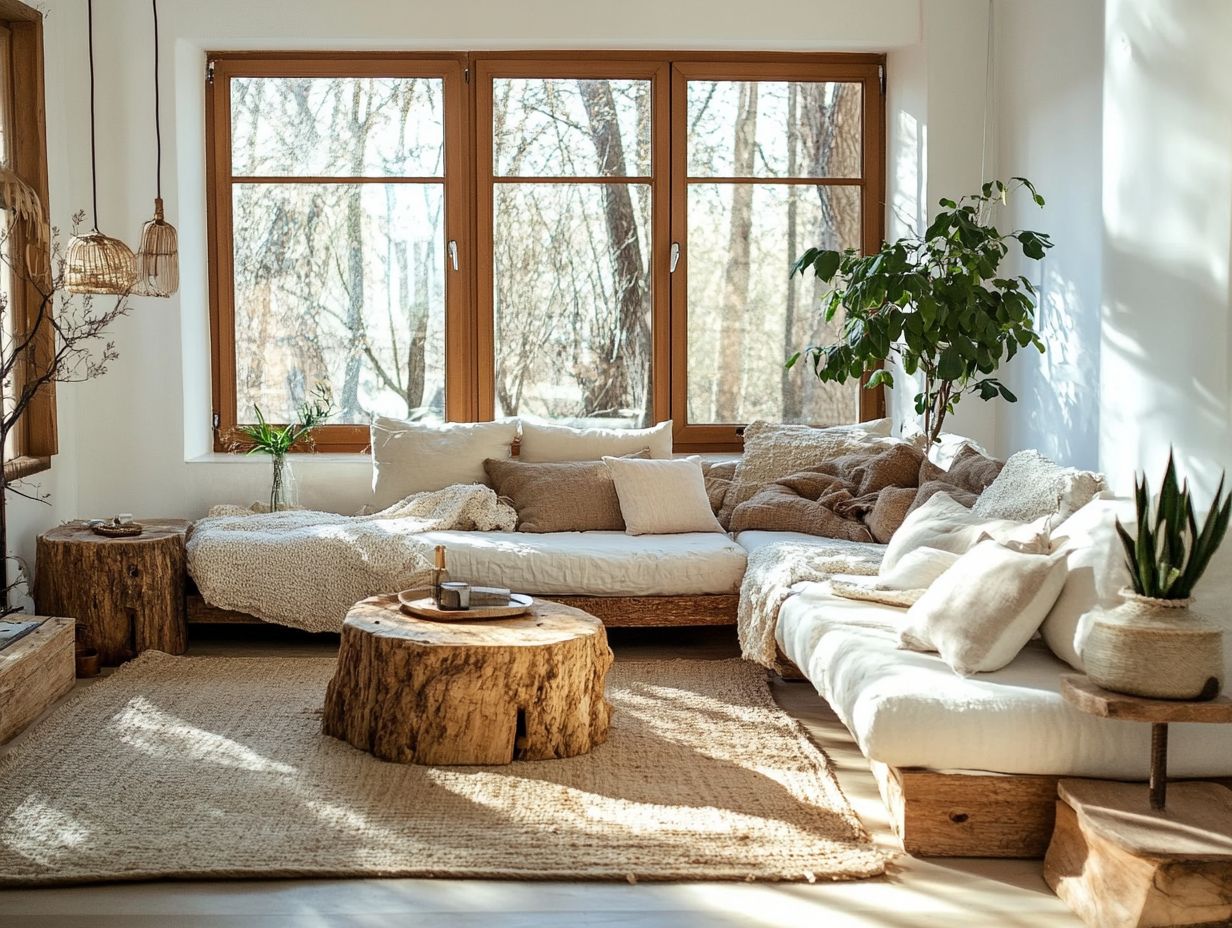
Sustainable decor uses sustainable materials for outdoor decor ideas and design techniques that minimize environmental impact. This includes renewable resources, waste reduction, and choosing responsibly sourced materials.
How can I incorporate sustainable materials into my decor?
Incorporate sustainable materials by using natural products like bamboo, cork, and reclaimed wood. Choose vibrant, eco-friendly paints and textiles made from recycled materials!
What are the benefits of using sustainable materials in decor?
Using sustainable materials lowers your carbon footprint and environmental impact. It supports responsible production and creates a healthier living space for your family.
Can sustainable decor still be stylish?
Absolutely! You can find many stylish and trendy options in sustainable materials for kid-friendly home decor that will elevate your home’s style while being eco-friendly.
How can I make my home more sustainable without completely redecorating?
Make small changes, like using energy-efficient appliances and installing low-flow faucets. Switching to LED light bulbs is another easy step toward sustainability!
Are sustainable materials more expensive than traditional materials?
Sustainable materials may cost more upfront, but they save you money over time through energy efficiency and durability. Investing in these materials supports responsible production practices.


